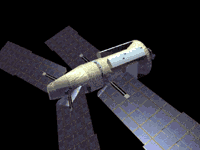Spektr
Part of the Mir Space Station program
 The Spektr module, the fifth Mir component to attain orbit, is primarily designed for Earth observation (specifically natural resources and atmospheric studies). The module also carries US/Russian equipment for material science, biotechnology, life sciences, and space technology studies. A small airlock and manipulator arm is also available to attach small external experiments and deploy small satellites. The module's total pressurized volume is 62 cubic meters.
The Spektr module, the fifth Mir component to attain orbit, is primarily designed for Earth observation (specifically natural resources and atmospheric studies). The module also carries US/Russian equipment for material science, biotechnology, life sciences, and space technology studies. A small airlock and manipulator arm is also available to attach small external experiments and deploy small satellites. The module's total pressurized volume is 62 cubic meters.
The module originally docked with the station on June 1, 1995, and was moved to its permanent location at a Mir core module radial port on June 2, 1995.
Spacecraft
2 3.9 kN main engines and 400N attitude control thrusters (NTO/UDMH) were used for initial approach and docking. 2 27 sq. meter solar arrays (6.9 kW), and 2 38 sq. meter arrays (9.3 kW) are attached to the module. Energy storage is available via a 360 A-hr NiCd battery system.
Payload
Balkan 1 lidar - measures upper cloud altutude. 5320 angstrom laser source, 4.5 m resolution
Phaza spectrometer - surface studies. Examines wavelengths between 0.340-285 micrometer, and provides 200 km resolution
Astra 2 - monitors atmospheric trace constituents, Mir environment
Taurus/Grif - monitors Mir's induced X/gamma ray background
KOMZA - interstellar gas detector
286K binocular radiometer
VRIZ UV spectroradiometer
EFO 2 photometer
MIRAS absorption spectrometer - measures neutral atmospheric composition (installed July 1995)
| Country of Origin | USSR |
| Size | 14.4 m long x 4.1 m diameter |
Launch Facts
| Name | Int'l Desig. | Date | Site | Vehicle | Orbit | Mass(kg) |
| Notes | ||||||
| Spektr | 1995-024A | 5/20/95 | Tyuratam | SL-13 | LEO | 19640 |
| MIR experiment module | ||||||
Information in The Mission and Spacecraft Library is provided without warranty or guarantee. USE AT YOUR OWN RISK.